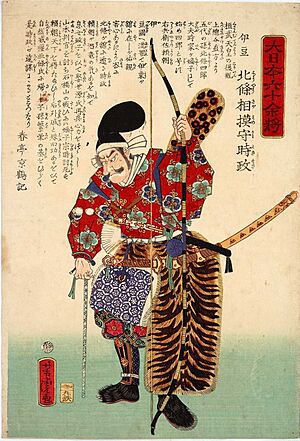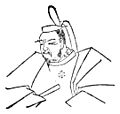Hōjō Tokimasa facts for kids
Quick facts for kids
Hōjō Tokimasa
北条 時政 |
|
|---|---|

Hōjō Tokimasa, Governor of Sagami Province in Dai Nihon Rokujūyoshō by Utagawa Yoshitora
|
|
| Shikken | |
| In office 1203–1205 |
|
| Monarch | Tsuchimikado |
| Shōgun | Minamoto no Sanetomo |
| Succeeded by | Hōjō Yoshitoki |
| Council of the Thirteen | |
| In office 1199–1200 Serving with Ōe no Hiromoto, Miyoshi no Yasunobu, Nakahara no Chikayoshi, Nikaidō Yukimasa, Kajiwara Kagetoki, Adachi Tōmoto, Adachi Morinaga, Hatta Tomoie, Hiki Yoshikazu, Hōjō Yoshitoki, Miura Yoshizumi, Wada Yoshimori
|
|
| Protector of Kyoto | |
| In office 1185–1186 |
|
| Succeeded by | Ichijō Yoshiyasu |
| Personal details | |
| Born | 1138 |
| Died | February 6, 1215 (aged 76-77) |
| Spouses | Daughter of Itō Sukechika Maki no Kata |
| Children |
|
| Parents |
|
| Signature |  |
Hōjō Tokimasa (北条 時政, 1138 – February 6, 1215) was an important Japanese samurai leader. He became the first shikken, or regent, for the Kamakura shogunate. A regent was like a powerful advisor who helped rule the country. Tokimasa was also the head of the Hōjō clan, a very influential family in Japan. He served as regent from 1203 to 1205.
Contents
Early Life and Family Connections
The Hōjō clan, Tokimasa's family, lived in a region called Izu Province, far from the main city of Kyoto. Not much is known about Tokimasa's early life before a young man named Minamoto no Yoritomo arrived in Izu.
During Tokimasa's youth, Japan was facing civil wars. These wars were mainly about who would rule the country. The two main families fighting were the Minamoto clan and the Taira clan. The Taira clan won these early battles, and many Minamoto family members were harmed.
However, Minamoto no Yoritomo, who was only 13 years old, was spared. He was sent to live in Izu, which was Tokimasa's family area. This event would change Tokimasa's life forever.
Tokimasa had several children. His most famous daughter was Hōjō Masako, born in 1156. She later fell in love with Minamoto no Yoritomo, the exiled leader. They married around 1180. This marriage was very important because it connected the Hōjō clan with the Minamoto clan.
The Genpei War and Rise to Power
In 1180, a prince called Prince Mochihito asked the Minamoto leaders to fight against the Taira clan. Yoritomo decided to go to war, and Tokimasa, his father-in-law, strongly supported him. This started a major conflict known as the Genpei War.
Yoritomo set up his main base and capital in Kamakura, in Izu. Tokimasa became his trusted advisor. The war was long and difficult, but the Minamoto clan slowly gained power. In 1185, the Minamoto clan finally defeated the Taira clan in a big sea battle called the Battle of Dannoura.
With the Taira defeated, Minamoto no Yoritomo became the most powerful leader in Japan. He decided to stay in Kamakura, not move to Kyoto. This meant Tokimasa remained close to the center of power.
In 1192, Yoritomo was given the title of shōgun by the Emperor. A shōgun was the supreme military leader of Japan. As the shōgun's father-in-law, Tokimasa became the head of one of the most important families in the country.
The Soga Brothers Incident
In 1193, an event known as the Revenge of the Soga Brothers happened during a large hunting trip organized by Shogun Minamoto no Yoritomo. Two brothers, Soga Sukenari and Soga Tokimune, sought revenge for their father's death by confronting Kudō Suketsune.
After this, one of the brothers, Tokimune, also confronted Shogun Yoritomo. Some historians believe that Tokimasa might have influenced Tokimune's actions. Tokimasa had a close relationship with the Soga brothers, and he had even been Tokimune's guardian. This incident showed Tokimasa's growing influence in the political world.
The Kamakura Shogunate and Tokimasa's Influence
In 1199, Minamoto no Yoritomo, the first shōgun, passed away. His son, Minamoto no Yoriie, became the next shōgun at 18 years old. However, Yoriie did not get along well with his grandfather, Tokimasa, or the Hōjō family.
Because Yoriie was young and sometimes acted without thinking, Tokimasa, along with his daughter Masako and son Yoshitoki, created a special council. This council was meant to help Yoriie rule. Tokimasa became a very powerful figure in this new government.
Tokimasa began to make strategic moves to increase the Hōjō clan's power. He removed rivals who disagreed with him. For example, a powerful leader named Kajiwara Kagetoki, who was close to Yoritomo, was removed from power in 1200. The Hōjō clan gained more land and influence after this.
As Yoriie grew ill in 1203, Tokimasa planned to divide Japan's rule between Yoriie's son, Minamoto no Ichiman, and Yoriie's younger brother, Minamoto no Sanetomo. Yoriie's father-in-law, Hiki Yoshikazu, suspected Tokimasa's plans and tried to act against him.
However, Tokimasa learned of Yoshikazu's plan. He invited Yoshikazu to his home and had him removed. After this, Hōjō troops also removed other members of the Hiki family, including Minamoto no Ichiman. Shogun Yoriie then gave up his position and was later removed from power in 1204. Many believe Tokimasa was involved in these events.
Minamoto no Sanetomo Becomes Shōgun
After Yoriie was no longer shōgun, Tokimasa made Yoritomo's second son, Minamoto no Sanetomo, the new shōgun. Tokimasa now held almost complete power as the regent.
However, Tokimasa's actions began to worry his own children. In 1204, his daughter Masako started to lose trust in him, especially after her son Yoriie was removed.
Tokimasa was then convinced that another important leader, Hatakeyama Shigetada, was planning a rebellion. Hatakeyama was married to Tokimasa's youngest daughter. Tokimasa ordered his sons, Hōjō Yoshitoki and Hōjō Tokifusa, to remove Hatakeyama. Even though his sons liked Hatakeyama, Tokimasa insisted. This event further damaged the trust between Tokimasa and his children.
Later Life and Retirement
By 1205, rumors spread that Tokimasa was planning to remove Shogun Sanetomo. His son Yoshitoki and daughter Masako were very worried about Sanetomo, who was Masako's last son. They placed Sanetomo under strong protection.
Realizing he had lost the support of his own family and had no more allies, Tokimasa decided to step down from his powerful position. He shaved his head and became a Buddhist monk, retiring from public life. His eldest son, Hōjō Yoshitoki, took over as the second Hōjō shikken (regent) for Shogun Sanetomo.
Tokimasa spent his final years peacefully in a Buddhist monastery in Kamakura. He passed away in 1215 at the age of 78.
Images for kids
-
The grave of Hōjō Tokimasa, in Izunokuni, Shizuoka Prefecture, Japan
See also



